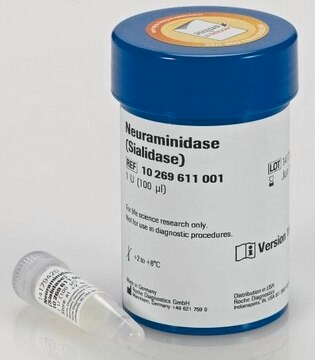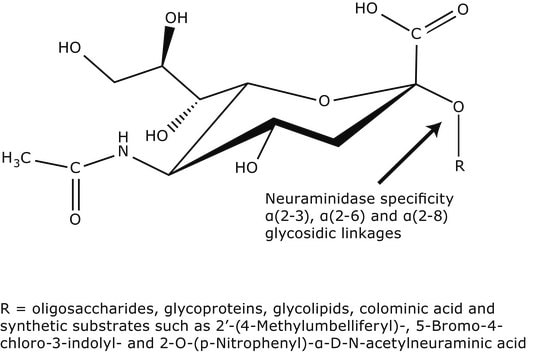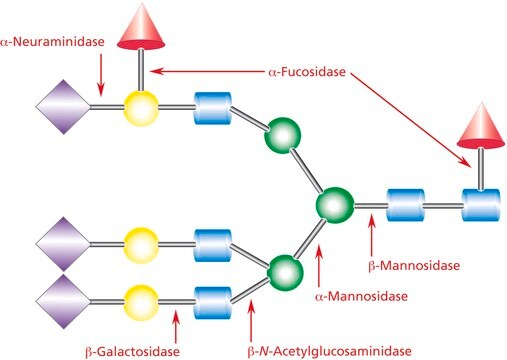11080725001
Roche
Neuraminidase (Sialidase)
from Vibrio cholerae
Sinonimo/i:
Salidase
Autenticatiper visualizzare i prezzi riservati alla tua organizzazione & contrattuali
About This Item
Prodotti consigliati
Origine biologica
Vibrio cholerae
Livello qualitativo
Forma fisica
solution
PM
~95 kDa
Confezionamento
pkg of 1 U
Produttore/marchio commerciale
Roche
pH ottimale
5.5-6.2
Compatibilità
suitable for ELISA applications
applicazioni
life science and biopharma
sample preparation
Condizioni di spedizione
wet ice
Temperatura di conservazione
2-8°C
Descrizione generale
Approximately 40 U/mg enzyme protein at 37 °C and pH 5.5, with N-acetyl-neuraminosyl-D-lactose as the substrate.
Neuraminidase is an acylneuraminyl hydrolase which hydrolyzes terminal N- or O-acylneuraminic acids which are α2,3-, α2,6-, or α2,8-linked (rate: α2,6 > α2,3 > α2,8) to oligosaccharides, polysaccharides, mucopolysaccharides, glycoproteins, and glycolipids. Noteworthy, for the hydrolysis of glycolipids, the presence of a detergent is necessary. Because of the broad substrate specificity, the enzyme is very well suited for the complete removal of sialic acids from glycoconjugates of a wide variety of biological materials (e.g., in cytology, on cell surfaces, viruses etc.).
Specificità
Hydrolyzes terminal N- or O-acyl-neuraminic acids that are α2,3-, α2,6-, or α2,8-linked to galactose, Hex, NAc, or N- or O-acylated neuraminyl residues in oligosaccharides/glycoconjugates or colominic acid. Relative rate of cleavage is α2,3 >α2,6 >α2,8, determined on bonds in tri- and tetrasaccharides.
Applicazioni
Neuraminidase has been used:
- to remove cis-acting sialic acids in CHO (chinese hamster ovary) cells
- for deglycosylation studies
Definizione di unità
One unit is the enzyme activity that hydrolyzes 1 μmol N-acetyl-neuraminosyl-D-lactose within 1 min at +37 °C under the following incubation conditions:
10 mM N-acetyl-neuraminosyl-D-lactose, 50 mM sodium acetate, 4 mM calcium chloride, bovine serum albumin, 100 μg/ml, pH 5.5. The activity is determined by measuring the released D-lactose using the β-galactosidase/galactose dehydrogenase method. Under the same conditions, 1 μmol N-acetylneuraminic acid per min is split off from human acid α1-glycoprotein (10 mg/ml incubation mixture) by 1 U neuraminidase. Released N-acetyl-neuraminic acid can be determined using, for example, the thiobarbituric acid method.
10 mM N-acetyl-neuraminosyl-D-lactose, 50 mM sodium acetate, 4 mM calcium chloride, bovine serum albumin, 100 μg/ml, pH 5.5. The activity is determined by measuring the released D-lactose using the β-galactosidase/galactose dehydrogenase method. Under the same conditions, 1 μmol N-acetylneuraminic acid per min is split off from human acid α1-glycoprotein (10 mg/ml incubation mixture) by 1 U neuraminidase. Released N-acetyl-neuraminic acid can be determined using, for example, the thiobarbituric acid method.
Stato fisico
Solution in 50 mM sodium acetate, 154 mM sodium chloride, 9 mM calcium chloride, 0.1% Micr-O-Protect (w/v), human serum albumin, 25 mg/l, pH 5.5. The preparation contains 10 mM EDTA.
Note: The serum used for this preparation was tested for HBs antigen and for the presence of antibodies to HIV-1, HIV-2, HCV, and found to be negative, according to the current quality control procedures.
Note: The serum used for this preparation was tested for HBs antigen and for the presence of antibodies to HIV-1, HIV-2, HCV, and found to be negative, according to the current quality control procedures.
Altre note
For life science research only. Not for use in diagnostic procedures.
Note legali
The sale of the Product does not exhaust or grant any rights in third party patents including patents of companies of the F. Hoffmann - La Roche AG group of companies, in particular, for the use of modified antibodies obtained by using the product.
Avvertenze
Warning
Indicazioni di pericolo
Consigli di prudenza
Classi di pericolo
Skin Sens. 1
Codice della classe di stoccaggio
12 - Non Combustible Liquids
Classe di pericolosità dell'acqua (WGK)
WGK 1
Punto d’infiammabilità (°F)
does not flash
Punto d’infiammabilità (°C)
does not flash
Certificati d'analisi (COA)
Cerca il Certificati d'analisi (COA) digitando il numero di lotto/batch corrispondente. I numeri di lotto o di batch sono stampati sull'etichetta dei prodotti dopo la parola ‘Lotto’ o ‘Batch’.
Possiedi già questo prodotto?
I documenti relativi ai prodotti acquistati recentemente sono disponibili nell’Archivio dei documenti.
I clienti hanno visto anche
Peter L Delputte et al.
Journal of virology, 81(17), 9546-9550 (2007-06-15)
The sialic acid-binding lectin sialoadhesin (Sn) is a macrophage-restricted receptor for porcine reproductive and respiratory syndrome virus (PRRSV). To investigate the importance of pSn sialic acid-binding activity for PRRSV infection, an R(116)-to-E mutation was introduced in the predicted sialic acid-binding
C K Liu et al.
Journal of virology, 72(6), 4643-4649 (1998-05-30)
The human JC polyomavirus (JCV) is the etiologic agent of the fatal central nervous system (CNS) demyelinating disease progressive multifocal leukoencephalopathy (PML). PML typically occurs in immunosuppressed patients and is the direct result of JCV infection of oligodendrocytes. The initial
Vanessa Schmidt et al.
The Journal of biological chemistry, 282(45), 32956-32964 (2007-09-15)
SorLA has been recognized as a novel sorting receptor that regulates trafficking and processing of the amyloid precursor protein (APP) and that represents a significant risk factor for sporadic Alzheimer disease. Here, we investigated the cellular mechanisms that control intracellular
Anshuman Das et al.
Nature microbiology, 5(9), 1069-1078 (2020-05-27)
The Picornaviridae are a diverse family of positive-strand RNA viruses that includes numerous human and veterinary pathogens1. Among these, hepatitis A virus (HAV), a common cause of acute hepatitis in humans, is unique in that it is hepatotropic and is
Il team dei nostri ricercatori vanta grande esperienza in tutte le aree della ricerca quali Life Science, scienza dei materiali, sintesi chimica, cromatografia, discipline analitiche, ecc..
Contatta l'Assistenza Tecnica.














